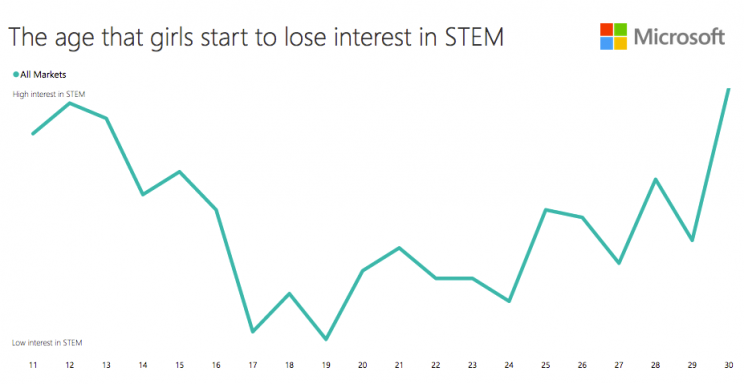New study pinpoints the age when girls lose interest in STEM subjects

It’s no secret that there is a dearth of women in science, technology, engineering and math (STEM) fields, but a new study may have actually pinpointed the exact age when young girls lose interest.
According to findings from a survey by Microsoft, young girls in Europe start to get captivated by these subjects at the age of 11, only to see that interest tail off at 15.
“Conformity to social expectations, gender stereotypes, gender roles and lack of role models continue to channel girls’ career choices away from STEM fields,” Martin Bauer, a professor of psychology and behavioural science at the London School of Economics who worked on the study, said in a story on the tech giant’s website.

The report, which surveyed 11,500 women and girls 30 and under from 12 European countries, found that interest in humanities also drops off at about the same age, but girls regained interest in those subjects “much more quickly.”
The study said the key reason women and girls cited that they didn’t pursue a career in a STEM-related field was because of a lack of a female role model.
Overall, 42 per cent said they would consider going into one of these fields in the future.
While the survey found that there has been progress on the part of teachers and parents, girls still need to be pushed towards STEM fields.
Nearly half of girls (41 per cent) said their teachers talk to them about these subjects or encourage them to pursue related careers. A similar number (38 per cent) said they receive the same support at home.
And this type of backing does seem to have a profound impact, 57 per cent of participants said having a teacher who did so would make it more likely for them to go after a STEM-related job.
“With more female role models, both in the classroom and at home, there’s a real chance to turn the tide on this trend,” said the study.
This need for role models, however, doesn’t appear to reflect a lack of confidence.
In fact, across Europe, between 46 and 68 per cent of girls rejected the idea that they would never be as good as their male counterparts at STEM subjects.
Another issue holding back women and girls from pursuing a career in related job sectors seems to be a general concern that there isn’t a level playing field.
Nearly 60 per cent of participants said they would feel more confident going after a STEM job if they knew both men and women would have “equal opportunities.”
“Girls believe anything is possible, but only if they are treated the same as boys,” said the report.
“Young women are confident that their generation is the first in which men and women will be truly equal in all areas of society, but acknowledge that men and women are treated differently in STEM jobs – and this perceived inequality is actually putting them off further STEM studies and careers.”
The study also found that practical experience with STEM subjects and learning about their real-life applications were key factors in keeping girls interested.
While some data has indicated that the gender gap is actually widening in some STEM fields, such as tech, Bauer said there is an increasing desire to bring about change.
“The problem is no longer lack of talent, but talent in the right career path. And one of the key issues is the fact that male and female students continue to make different career choices.
“But there’s a growing movement in our society who not only understands that both STEM and humanities skills are crucial for today’s workforce, but who also care deeply about removing obstacles to gender equality in STEM careers.”
More from Yahoo Canada Finance:



